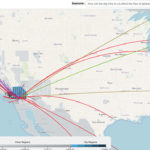 The process of leaving the European Union has perhaps shed fresh light on the inherent complexities of supply chains that increasingly span the globe. That these global supply chains manage to underpin lean manufacturing systems where seconds count is one of the more amazing feats of modern life.
The process of leaving the European Union has perhaps shed fresh light on the inherent complexities of supply chains that increasingly span the globe. That these global supply chains manage to underpin lean manufacturing systems where seconds count is one of the more amazing feats of modern life.
A new project led by Northern Arizona University aims to visualize the complexity of supply chains by showing how food, water and energy move throughout the United States.
The FEWSION Project aims to map food, energy and water supply to every community in the US, providing a publicly available resource for various potential user groups to utilize. The data is pulled from various federal agencies and universities from across the country, with the team suggesting this is the first time it has been pulled together and visualized like this.
“This is a way to see that big data, to see your supply chains, see your lifelines,” they say. “We look at exposure. If you have a lot of exposure in your supply chain, there is a strong potential for you to be affected by a drought, storm or decision far away.”
Supply chain mapping
The tool allows people to easily map the source of their communities food, energy and water, with the team believing this can help to change buying behaviors, especially for those who wish to buy more local produce or more sustainable energy.
It has the potential to go beyond that however, and the team suggest one interesting use case could be for emergency managers to plan contingencies in the event of a disaster or other emergency situation.
“People want to know: How am I impacted locally? How is something happening on the other side of the country going to affect my life here?” the team say. “Being able to have that data on hand visually and to be able to explore it is a really valuable tool.”
The maps help to show the inherent connection between rural and urban communities, and the team believe it can help to erode the conceptual divide between groups who seem increasingly unable to conceive the others point of view.
“When you see those connections, you can understand how to vote and spend your dollars in ways that benefit everyone—urban and rural—because we’re all part of the same system,” they explain.
Whilst that may be a slightly grandiose ambition in our ever more polarized society, any help in breaking down barriers has to be applauded.